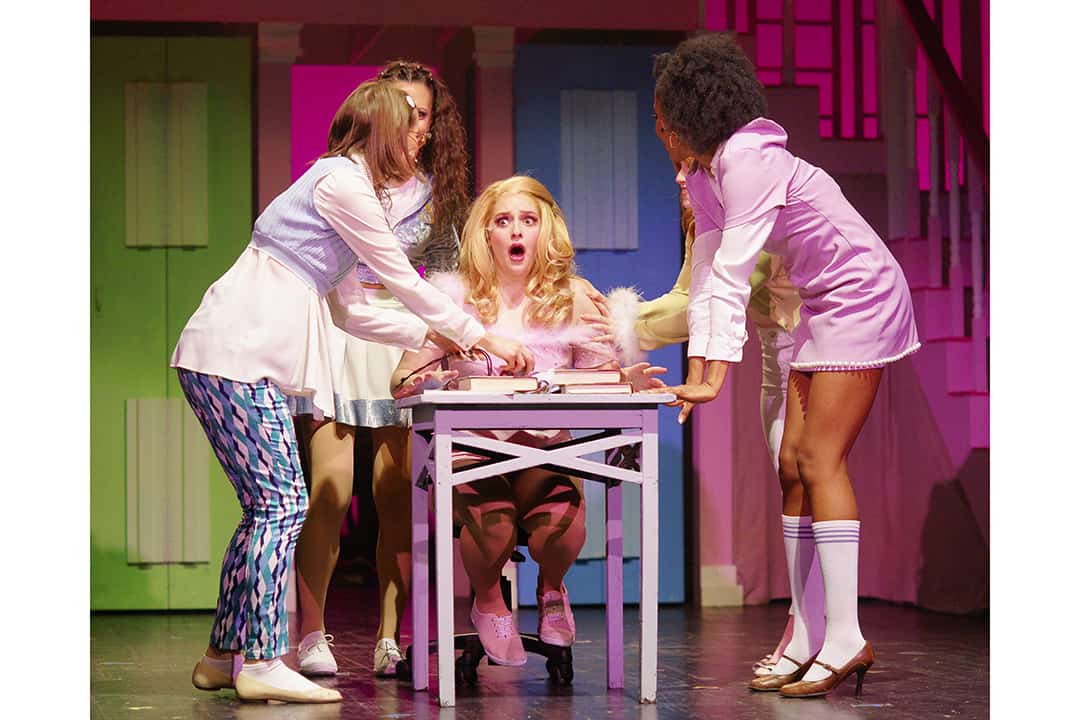Emma Sangalli is truly the star in Hart House’s Legally Blonde: The Musical. Every part of her performance, from vocals to acting to her connection with the audience, is brilliant. She enters the staged Harvard University with the same natural presence as Reese Witherspoon’s on-screen version. Sangalli’s interpretation of Elle Woods is simply irresistible.
In fact, Legally Blonde is carried most of all by its captivating characters. They’re all easily divided into the ‘good’ and the ‘bad,’ the nice versus the mean. Yes, these are stereotypes, but the main cast are so charming that you can’t even be annoyed with their predictability. And regarding the more unpleasant characters, Woods herself shows us how to deal with them: with compassion.
The thing is, we — the audience — love Elle. We love her not because she’s pretty, which she is; not because she’s smart, though she’s way smarter than the uptight Harvard boys; and not even because she’s funny — that girl’s got humour. No, we love her because of her heart.
This is how big her heart is: when her boyfriend breaks up with her, she doesn’t react with denial or anger, and she doesn’t scream, cry, or even pity herself, which she would have every right to do. Instead, she stays true to her heart, calmly but sadly saying to her disloyal boyfriend “I love you.”
Elle teaches us to do it for love, to stay true to oneself, and to do what you need to reach your goals — even if you end up at a party dressed with bunny ears and a negligee among a bunch of preppy law school students, or when the scariest professor on campus kicks you out of class day after day. Elle goes through all of these things with her head held high and her heart kept open.
If anyone thought Elle does what she does because she’s naïve, she proves them wrong at the final trial. There, she shows that she’s not only smart and a caring friend, but also displays how that very combination is a winning concept.
Other characters you will fall in love with in Legally Blonde are the endearing Emmett Richmond (Ethan Vasquez Taylor) and Paulette Bonafonté (Moulan Bourke), as well as Chelsea Jayne Bray’s Enid Hoopes. Rae Bernakevitch is another cast member worth mentioning, even though her role as Kate is a small one.
After falling in love with all these characters on the stage, after laughing and crying with them for over two hours, how can I care about the minor details that didn’t quite fall into place? That the energy sometimes fell flat in less than smooth bridges between songs and scenes, or that a couple of minor characters seemed more sleepy than anything else — how could I mind such details?
The opening scene isn’t quite convincing in the girly glitter it’s supposed to convey. What I saw on stage doesn’t live up to what I heard in the song. However, Elle now sits on my shoulder and challenges me: Didn’t I see you shiver during the show? Didn’t you smile, and laugh, and cry?
The answers are yes, yes, yes, and yes — Emmett, I blame you twice for that last yes — during the show I did all of those things. Elle taught me that the feelings the performance gave me matter more than anything else. If there were things I felt were lacking in the beginning of the show, or here and there throughout, the overall performance made up for it.
Beyond the endearing characters and Sangalli’s excellent performance, Gregory Carruther’s choreography is also delightful all throughout the show. The rope-skipping dance number was the most impressive, not least because of how the actors seamlessly pause their skipping and then picking it up again, making it look like the easiest thing in the world.
The set design is hardly as avant-garde or creative as it could have been, but it serves the show well — both the geographical transportation across the US and the actual movements across the stage are combined with nice transitions. That the musicians are visible, even though just barely, through a door at the back of the set is a tiny detail that adds to the vividness on stage.
When Elle first encounters peer Harvard student Vivienne Kensington (Autumn-Joy Dames), she criticizes Elle’s pink fashion choices. At the end, however, the newfound friend Vivienne has come to the realization that “being true to yourself never goes out of style.” What Hart House Theatre’s Legally Blonde shows us is not only that staying true to yourself is eternally fashionable, but also that it’s an essential life skill.


